How Accident Scene Photos Can Increase the Value of a Car Crash Claim
You only have a short amount of time after a car crash to gather evidence and preserve your right to seek compensation. What are the things you can do that will actually help your settlement? First, make sure you file a police report. Second, take this chance to exchange contact information with the other driver. Third, get the medical care you need. Finally, use your phone to take high-quality photos of the accident scene.
There are a lot of ways that good photographs can help you as you pursue a personal injury settlement. Learn more now, and when you’re ready to start your claim, call Burns, Cunningham & Mackey at 251-336-3410.
Compare a Description of a Car Crash Scene to Photos
Think about how you would describe a car crash to what information you get from even one photograph. As you look at the scene of your T-bone accident, you might say that the other vehicle has pushed your vehicle about 10 feet in the intersection, leaving your car crumpled. There are stoplights on all four sides, and you had a green light at the time of the accident. The other vehicle has minor damage, due to its size and build.
Now, the information you could get from a photo is much more detailed and useful. A photo would show shattered glass covering the intersection. It would show the smoke rising from the hood of your car, and the cars around you that had to swerve to avoid hitting you and causing a secondary accident.
You could see the fact that there were no skid marks from the other car, indicating that they didn’t take any evasive action to prevent the crash. The data found in the photo file would show exactly when it was taken, which would make it easy to look at the stoplights’ schedule and figure out who had the green light.
Having all of this information available to you makes the entire settlement or lawsuit process easier.
Photos Help at Every Single Stage
When you hire an attorney, they will use the crash scene photos you took to power their investigation. They can get a lot more specific information from photos than from your retelling of the crash. From there, they can build a more solid case proving your injuries and the other party’s negligence.
Photos can be very useful when it comes to securing a fair settlement from the other party’s insurance. When they can’t see the damage their client has done, it’s far easier for them to wave it away and assume that you are exaggerating. With photographic proof, they are put in a much tougher position.
Should your case go to court after unsuccessful negotiations, you will find that your photos may be a key component of your case. Photos put jury members in a position where they can truly understand the scope of damage caused.
High-Quality Photos Provide Context
Photographs often provide context that would otherwise be missing from your claim. For example, consider a crash on a rural road. The photographs show that the stop sign on the other driver’s side is completely obscured by poorly maintained trees and bushes, which is obvious in the background of your photo. This might give both parties the chance to seek compensation from the municipality.
Taking the Right Photos is Crucial
It’s difficult to know which photos are the “right” photos at the moment. Instead, focus on taking as many photos as possible. Take photos from different angles and distances. Include as many identifying details as you can, including license plates, street signs, speed limit signs, and proof of damage to both vehicles. If you are injured, you may also want to take photos of your injuries prior to getting them treated.
Begin Your Car Accident Claim With the Help of Burns, Cunningham & Mackey
Once you have sought medical care and you’re ready to explore your legal options, take a few minutes to reach out to the team at Burns, Cunningham & Mackey. We’re committed to helping you fight for the compensation you’re owed. Call us at 251-336-3410 or contact us online now.





Leave a Reply
Want to join the discussion?Feel free to contribute!